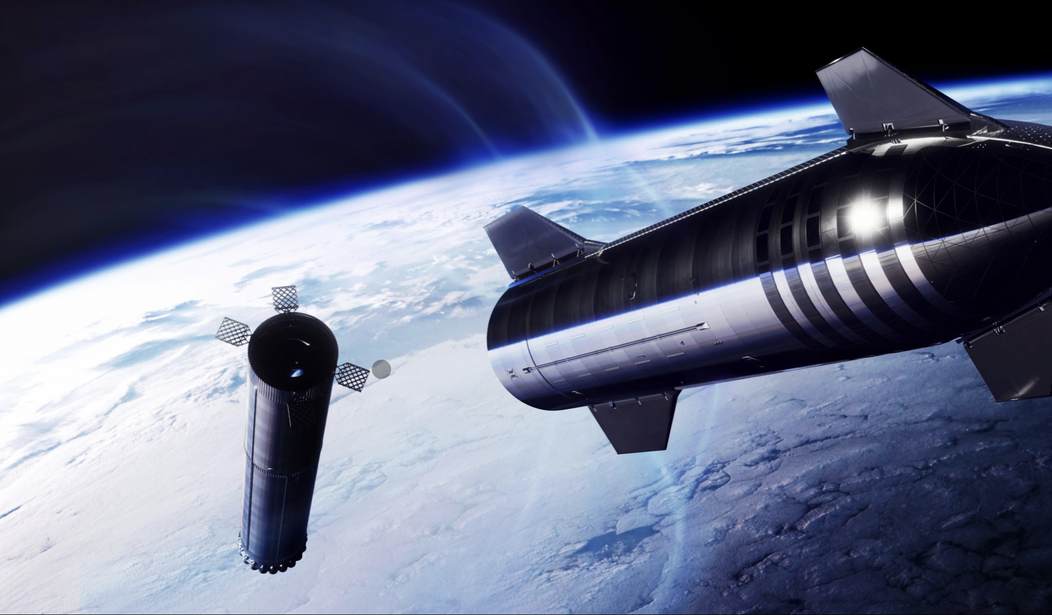It’s all-but-official that Elon Musk’s world-changing Starship rocket will attempt its first orbital test flight on Monday, April 10.
Beset by two years of foot-dragging regulatory delays courtesy of the Biden administration, the Federal Aviation Administration (FAA) now says Starship will blast off from Boca Chica, Texas, on Monday, April 10, according to the Daily Mail. Other sources link to a new FAA air traffic advisory revealing “SPACEX STARSHIP SUPERHEAVY BOCA” with a launch date of 4/10/23 and, if necessary, backup launches approved for April 11 and 12.
The FAA license has yet to be issued but the scheduling indicates the FAA expects to issue it in the coming days.
The orbital test flight is supposed to be a short one, with Starship making a single orbit and then attempting a “belly-flop” reentry maneuver, followed by a sea-based landing on recovery near Hawaii just 90 minutes later. The launch stage will separate about three minutes into the flight, if all goes as planned, and land on a SpaceX recovery ship in the Gulf of Mexico.
If everything doesn’t go as planned, we could witness serious fireworks anywhere from Texas to Hawaii.
The flight’s first-stage recovery isn’t much different from anything SpaceX has already accomplished 183 times out of 194 attempts with its workhorse Falcon 9 rocket. It’s been a little over two years since the company failed to recover a Falcon.
Nevertheless, Musk rates Starship’s chances of a successful test flight at just 50%. “I’m not saying it will get to orbit, but I am guaranteeing excitement,” he said at a Morgan Stanley Conference in March, adding that the test “Won’t be boring!”
Indeed. One way or another, space fans will witness an Earth-shattering kaboom.
“Starship” is the name of the fully-reusable spaceship but also refers to the entire stack of a Starship plus the Super Heavy first-stage launch vehicle — which is also fully reusable. Musk’s plan is to eventually construct thousands of Starships and reduce the turnaround time from launch to recovery to re-launch to a mere hours. SpaceX will apply mass-production lessons Musk learned at Tesla to the volume production of Starship stacks. He’s already done so with Falcon 9.
Exclusively for our VIPs: You Don’t Need a Study to Know That Pets Are Good for Your Kids’ Health
The other super heavy lift vehicle is Boeing’s SLS, painstakingly custom-built, one at a time, for NASA’s Artemis program to establish a permanent human presence on the Moon. But you can’t really compare the two.
SLS can deliver 26 tons of cargo (including astronauts and their necessities) to the Moon. If SLS development continues — an open question I’ll get to momentarily — later versions of the rocket should be able to deliver nearly double that at 46 tons. Starship can only deliver 21 tons to the Moon — directly. However, Musk’s rocket can deliver an incredible 100 tons to low-Earth orbit (LEO), and with orbital refueling, can then deliver all 100 tons to the Moon.
One model of Starship is — you guessed it — a LEO refueling station.
Each SLS launch costs a budget-busting $4.1 billion, and that’s just for the rocket. Musk claims he can get Starship launches down to $2 million, once it’s operating at scale. But even if he’s off by a factor of 100 (which he likely will be at first), a Starship launch would cost one-eighth what SLS does, or $200 million.
Now let’s double the cost of Starship because SpaceX will need to launch that refueling spaceship, too, to deliver a maximum load to the Moon.
My worst-case, back-of-the-envelope math says that Starship will cost one-tenth as much per launch, with the ability to deliver two to four times as much mass to the Moon.
A fully-loaded Starship voyage to the Moon, in our worst-case example, will cost $400,000 per ton. The best-case delivery cost for SLS is $89 million per ton, on a version of SLS that only exists on paper. The extant version of SLS will cost taxpayers a hefty $158 million per ton.
At the SLS price, not even Midas could afford to build a base on the Moon. I doubt SLS will ever see more than a handful of flights and the heavier-lift versions will never leave the drawing board, much less the Earth.
That’s because SpaceX costs will come down over time but Boeing’s have never gone anywhere but up.
As I said, this is world-changing stuff. But I didn’t say which world.
Musk’s dream is to establish a self-sustaining human colony on Mars. To do so will require thousands of Starship launches matched (IIRC) with an equal number of refueling flights.
The primary mission for Starship isn’t to orbit Starlink internet satellites, provide heavy lift for science probes that have until now been impossible to launch, or even to make it affordable for NASA to build a city on the Moon — although all of these things will happen if Starship development succeeds.
The primary mission is to remake the face of Mars, to transmute some small section of the Red Planet from an alien world to a human one —- within the lifetimes of most people alive today.
I don’t know if Musk can accomplish that highly unlikely feat, but I’ll be watching every step of the way, starting with Starship’s first orbital test flight — I hope — next week.
Besides, whether one particular launch succeeds or fails, hope is what spaceflight is all about.










